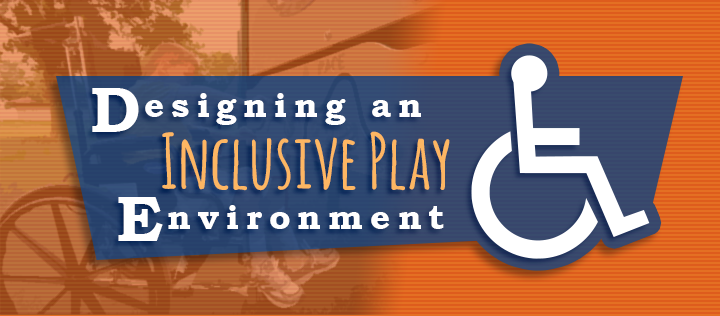Designing an Inclusive Play Environment

We understand that playgrounds offer a number of physical and cognitive benefits for children. But not every child approaches the playground with the same set of circumstances and/or abilities. Ensuring that each child can enjoy at least some activity on a commercial play structure is a matter of including accessible playground equipment.
According to the 2010 Census by the United States Census Bureau, 5.2% or approximately 2.5 million children between the ages of 2-17 years have a disability in the U.S. A disability could be any kind of impairment, from hearing, speech, language, visual, or a learning hardship that is a result from any one of those impairments, to physical, mental, or health difficulties.
The Americans with Disabilities Act (1990) applies to all public use playgrounds to ensure that children with disabilities are accommodated with equal access. For children with disabilities, these accommodations can include ADA compliant ramps, specially designed commercial play structures or fitness equipment, and safety surfacing options that make it easy to traverse to, and participate in, many aspects of a given playground. Playground professionals call this accessibility and specialty product design “inclusive play.”
Inclusive Play is the development of play spaces that serve the physical, sensory, cognitive, emotional, and social needs of children of all abilities. It combines ADA accessibility with diverse play components to involve children with and without disabilities in meaningful interaction, educational experiences, and fun activities.
Elements of an Inclusive Play Environment
There are a variety of aspects that go into designing an inclusive play environment for children with special needs. The objective when planning municipal parks, or residential community play areas, is to consider not only accessibility, but also a diverse selection of activities that engage children of all ability levels.
- Social interaction is important. Children must be able to access most or all of the playground structure in order to participate in play with each other, regardless of any limitations to their physical capabilities. Creative opportunities such as the Store Panel at ground level of some of our commercial play structures encourage group play and acceptance.
- Learning activities should be geared to children who are discovering advanced concepts, and should also be simple enough to demonstrate basic principles such as cause and effect. This engages children of all abilities to explore their cognitive reasoning skills through independent play.
- Inclusive play components should be easily understandable to allow children to effectively participate and gain confidence through the demonstration of their capabilities.
- Children are active, and it’s important to provide play components that challenge kids, but are well within the bounds of their capabilities. Play components that promote healthy physical stimulation should be designed to minimize unnecessary fatigue.
- Sensory stimulating components should be factored into an inclusive playground. These may include sound activities, water and sand activities, exploration opportunities, and others.
Our commitment to ensure that every child is given the same opportunity to enjoy every playground we install is of the utmost importance. At All People Can Play we utilize all of those elements and more in our Commercial Play Structures to help create an inclusive playground environment. Contact us to learn more about our ADA accessible structures, and what our team of playground professionals can do to help you design your own inclusive playground environment.


